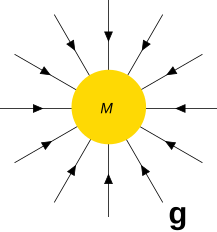OCR Specification focus:
‘Gravitational fields arise because objects with mass exert attractive influence.’
Massive objects interact through a gravitational field, an invisible region of influence extending through space. Understanding how mass produces this field is fundamental to analysing gravitational interactions.
The Nature of Gravitational Fields
A gravitational field is a region in which a mass experiences an attractive force due to another mass. This concept allows physicists to model gravitational influence even when objects are not physically touching. The field idea replaces the need to think of gravity as acting instantaneously across distance and instead describes how space around a mass is altered in a way that affects other masses.
Gravitational Field: A region of space in which a mass experiences an attractive gravitational force due to another mass.
Gravitational fields are always attractive, reflecting the fact that mass only produces attraction, not repulsion. Every object with mass generates its own gravitational field, but the strength of this field varies depending on the size of the mass and the distance from it.
One useful way to conceptualise this is to consider the field as a physical model that connects the presence of mass to the force experienced by another mass. This approach aligns with the specification statement that mass generates gravitational fields, emphasising a direct causal link.
Mass as the Source of Gravitational Fields
According to Newtonian physics, mass is the fundamental source of gravity. The greater the mass, the stronger the gravitational influence it exerts. This means that astronomical bodies such as planets, stars, and moons produce significant gravitational fields, shaping motions throughout the universe.
How Mass Gives Rise to a Field
The production of a gravitational field can be visualised conceptually using the idea of mass “disturbing” or “modifying” the surrounding space.

Diagram of a Newtonian gravitational field around a single spherical mass. The arrows point radially inward, indicating that gravitational force always acts towards the mass. This visual emphasises that the mass generates an attractive field throughout the surrounding space, consistent with the field description used in Newtonian gravitation. Source.
Key points include:
Every mass creates a field; even small masses generate gravitational influence, although often too small to detect.
The field extends infinitely, though its strength decreases with distance.
Field strength is radial, spreading outward from the mass in all directions.
These ideas support an intuitive understanding of how gravitational effects propagate through space.
Gravitational Interaction Through Fields
The field model provides a powerful explanatory tool. Instead of masses pulling directly on each other, each mass creates a field that alters the conditions around it. A second mass placed in this region experiences a force because it responds to the field, not because the first mass exerts an instantaneous pull.
Test Mass: A small mass introduced into a field to detect or measure the field’s properties without significantly altering it.
When a test mass is placed within a gravitational field, it experiences a force whose magnitude depends on the field strength at that point. This allows physicists to separate the concept of the field from the specific object under investigation.
The use of test masses leads directly to the quantitative description of gravitational effects.
Gravitational Field Strength
Gravitational field strength, denoted by the symbol g, expresses how strong a gravitational field is at a particular point.
EQUATION
—-----------------------------------------------------------------
Gravitational Field Strength (g) = F / m
F = Gravitational force acting on the test mass (newtons, N)
m = Test mass placed in the field (kilograms, kg)
—-----------------------------------------------------------------
A brief normal sentence ensures separation from the previous equation block. The field strength g provides a convenient way to compare gravitational conditions at different locations and around different masses.
Using Field Strength in Descriptions
With field strength defined, it becomes possible to describe how a mass’s gravitational influence varies with position. Close to massive objects, g is large; far away, it becomes small. Although later subsubtopics introduce the inverse-square law, the essential point here is that the presence of mass alone is sufficient to generate a measurable field.
Visualising Gravitational Fields
Gravitational fields can be represented using gravitational field lines, which illustrate the direction and relative strength of the field around a mass.

Gravitational field lines drawn around the Earth, showing how the field produced by Earth extends into surrounding space. The lines point towards the planet, illustrating the attractive and radial nature of gravitational fields around spherical masses. The closer spacing of lines near the surface shows the stronger field in that region. Source.
Key properties include:
Lines point towards the mass because gravity is attractive.
Lines are radially inward for spherical masses.
Closer spacing of lines indicates stronger field strength.
Field lines never cross, reflecting that the field has one direction at each point.
These diagrams help students conceptualise how gravitational influence varies and how it acts on objects placed within the field.
The Significance of Mass in Gravitational Theory
The idea that mass generates gravitational fields underpins all later gravitational concepts. Whether describing field strength, gravitational potential, or orbital motion, the starting point is always that mass produces a region of influence extending outward indefinitely. This unifying principle reinforces the fundamental role of mass in shaping interactions across the universe.
FAQ
Gravitational fields are detected through their effects. When a small test mass placed near another mass accelerates without contact, this indicates a field is present.
Observations such as satellite orbits, falling objects, and tidal effects all demonstrate that masses influence their surroundings in a consistent and predictable way.
Scientists use these measurable effects to map the field’s strength and direction, even though the field itself is invisible.
A test mass must be small enough that its own gravitational field does not noticeably affect the system under investigation.
If it were too large, it would alter the field being measured, making it difficult to determine the field produced solely by the original mass.
A small test mass ensures:
Minimal disturbance to the surrounding field
A clear measurement of the force acting upon it
Reliable field strength calculations
Yes. Any object with mass generates a gravitational field, no matter how small its mass may be.
However, the field from very small objects is so weak that it is effectively impossible to measure with ordinary equipment.
Fields from everyday objects such as people or furniture technically exist, but they are negligible compared with planetary, stellar, or lunar fields.
A perfectly spherical mass with uniform density distributes its mass evenly in all directions around its centre.
This symmetry means the gravitational influence is the same in all radial directions, producing a spherical and uniform pattern of field lines.
The symmetry breaks only if the mass is irregular, rapidly rotating, or has varying density, which can distort the local gravitational field.
Doubling the mass would double the strength of its gravitational field at every point in space.
This means:
Any test mass nearby would feel twice the gravitational pull
Field lines would be drawn closer together, illustrating increased strength
Orbital motions around the object would change accordingly, requiring new speeds and radii to maintain stable orbits
Although this thought experiment is artificial, it illustrates the direct proportional relationship between mass and gravitational field strength.
Practice Questions
Question 1 (2 marks)
Explain what is meant by a gravitational field and state the direction of the gravitational field produced by a spherical mass.
Question 1 (2 marks)
• Gravitational field is a region in which a mass experiences an attractive gravitational force. (1)
• Field produced by a spherical mass is directed radially inwards towards the centre of the mass. (1)
Question 2 (5 marks)
A student states that gravitational forces act instantaneously between two masses, even when they are far apart.
Using the concept of gravitational fields, explain why this statement is incorrect.
In your answer, describe how a mass generates a gravitational field, how another mass interacts with this field, and why the field model is useful for understanding gravitational attraction.
Question 2 (5 marks)
• A mass produces a gravitational field in the space around it. (1)
• The field exists independently of another mass being present. (1)
• A second mass experiences a force because it responds to the gravitational field, not because of direct instantaneous action from the first mass. (1)
• The field model avoids the need to assume instantaneous action at a distance; the field conveys the gravitational influence. (1)
• Explanation that the model helps describe strength and direction of gravitational influence at different points in space. (1)

